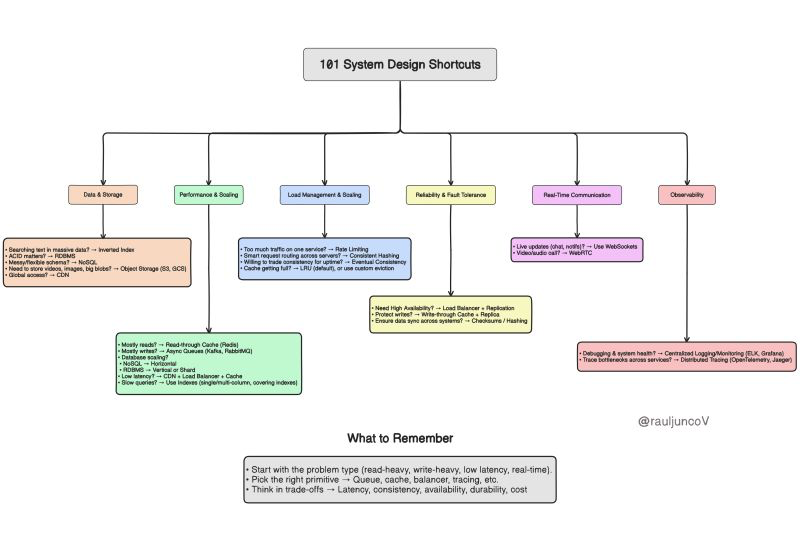With AI writing more code, System Design gets more important every day.
101 System Design Shortcuts.
Data & Storage
• Searching text in massive data? → Inverted Index
• ACID matters? → RDBMS
• Messy/flexible schema? → NoSQL
• Need to store videos, images, big blobs? → Object Storage (S3, GCS)
• Global access? → CDN
Performance & Scaling
• Mostly reads? → Read-through Cache (Redis)
• Mostly writes? → Async Queues (Kafka, RabbitMQ)
• Database scaling?
• NoSQL → Horizontal
• RDBMS → Vertical or Shard
• Low latency? → CDN + Load Balancer + Cache
• Slow queries? → Use Indexes (single/multi-column, covering indexes)
Load Management & Scaling
• Too much traffic on one service? → Rate Limiting
• Smart request routing across servers? → Consistent Hashing
• Willing to trade consistency for uptime? → Eventual Consistency
• Cache getting full? → LRU (default), or use custom eviction
Reliability & Fault Tolerance
• Need High Availability? → Load Balancer + Replication
• Protect writes? → Write-through Cache + Replica
• Ensure data sync across systems? → Checksums / Hashing
Real-Time Communication
• Live updates (chat, notifs)? → Use WebSockets
• Video/audio call? → WebRTC
Observability
• Debugging & system health? → Centralized Logging/Monitoring (ELK, Grafana)
• Trace bottlenecks across services? → Distributed Tracing (OpenTelemetry, Jaeger)
Advanced Patterns
• Circuit Breaker → Isolate failing components to prevent cascading failures
• Bulkhead → Partition system resources to contain failures
• Throttling → Limit usage to protect downstream systems
What to Remember
• Start with the problem type (read-heavy, write-heavy, low latency, real-time).
• Pick the right primitive → Queue, cache, balancer, tracing, etc.
• Think in trade-offs → Latency, consistency, availability, durability, cost
What would you add to this list?
